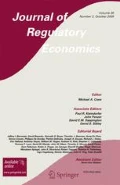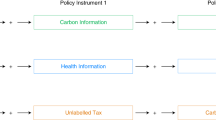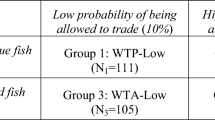Abstract
A calibrated model is used to determine the welfare impacts of various regulatory instruments for improving health. The results of a lab experiment are integrated in a partial equilibrium model representing demands for two kinds of fish, one with higher nutritional benefits (canned sardines) and one with higher contamination risks (canned tuna) in France. In the laboratory, information about health effects leads to a statistically significant decrease (increase) in the willingness to pay for tuna (sardines). Simulations with the laboratory results show that, for most cases, a per-unit tax on tuna and a per-unit subsidy on sardines without any information revealed to consumers lead to the highest welfare, because both the tax and subsidy directly internalize health characteristics. The information policy combined with a per-unit tax on tuna and a per-unit subsidy on sardines is socially profitable only if a large proportion of consumers (greater than 95%) receives health information.
Similar content being viewed by others
References
Adamy, J. (2005). Testing company plans to market fish lower in mercury next year. Wall Street Journal, November 2, D4.
AFSSA (Agence Française de Sécurité Sanitaire des Aliments) (2002). Avis relatif à l’évaluation des risques sanitaires liés à l’exposition au mercure des femmes allaitantes et des jeunes enfants. Saisine no 2002-SA-0014, 22 Novembre 2002, Maison-Alfort, France.
AFSSA (Agence Française de Sécurité Sanitaire des Aliments) (2004). Avis relatif à la réévaluation des risques sanitaires du méthylmercure lies à la consommation des produits de la pêche au regard de la nouvelle dose hebdomadaire tolerable provisoire (DHTP). Saisine no 2003-SA-0380, 16 Mars 2004, Maison-Alfort, France.
AFSSA (Agence Française de Sécurité Sanitaire des Aliments) (2006). Communiqué de presse. Consommation de poissons et méthylmercure. Maisons-Alfort, France, le 25 juillet 2006. http://www.afssa.fr/ftp/afssa/36507-36508.pdf (accessed August 2007).
Beales H., Craswell R., Salop S. (1981). The efficient regulation of consumer information. Journal of Law and Economics 24: 491–544
Binswanger H.P. (1980). Attitudes toward risk: experimental measurement in rural India. American Journal of Agricultural Economics 62: 395–407
Brett C., Keen M. (2000). Political uncertainty and the earmarking of environmental taxes. Journal of Public Economics 75: 315–340
Buchanan J. (1969). External diseconomies, corrective taxes, and market structure. American Economic Review 59: 174–177
Calabresi G. (1961). Some thoughts on risk distribution and the law of torts. Yale Law Journal 70(4): 499–553
Cash S.B., Sunding D.L., Zilberman D. (2006). Fat taxes and thin subsidies: prices, diet, and health outcomes. Acta Agriculturae Scand C: Food Economics 2: 167–174
Chouinard, H., Davis, D., LaFrance, J. T., Perloff, J. M. (2007). Fat taxes: big money for small change. Forum for Health Economics and Policy, 10(2), Article 2. http://www.bepress.com/fhep/10/2/2 (accessed August 2007).
Crépet A., Tressou J., Verger P., Leblanc J.C. (2005). Management options to reduce exposure to methylmercury through the consumption of fish and fishery products by the french population. Regulatory Toxicology and Pharmacology 42: 179–189
Crespi J.M., Marette S. (2001). How should food safety certification be financed?. American Journal of Agricultural Economics 83: 852–861
EC (European Commission) (2005). Regulation (EC) No 78/2005 of 19 January 2005. Amending Regulation (EC) No 466/2001 as Regards Heavy Metals. http://eur-lex.europa.eu/LexUriServ/site/en/oj/2005/l_016/l_01620050120en00430045.pdf (accessed September 2006).
EC (European Commission) (2006). Environment: Commission Proposes Ban on EU Mercury Exports. Press Release IP/06/1481 26/10/2006, Brussels. http://europa.eu/rapid/pressReleasesAction.do?reference=IP/06/1481&format=HTML&aged=1&language=EN&guiLanguage=en (accessed April 2006).
The Economist (2006a). Food for Thought. January 21, p. 14.
The Economist (2006b). The Omega Point. January 21, pp. 72–73.
EFSA (European Food Safety Authority) (2005). Opinion of the scientific panel on contaminants in the food chain on a request from the European parliament related to the safety assessment of wild and farmed fish. EFSA Journal, 236, 1–118. http://www.efsa.eu.int (accessed February 2006).
EPA (U.S. Environmental Protection Agency) (2004). What you need to know about mercury in fish and shellfish. Washington, DC. http://www.epa.gov/waterscience/fishadvice/advice.html (accessed March 2006).
Gayer, T., & Hahn, R. (2005). The political economy of mercury regulation. Regulation, Summer, 26–33.
Gayer T., Hahn R. (2006). Designing environmental policy: lessons from the regulation of mercury emissions. Journal of Regulatory Economics 30: 291–315
Gustavsen G., Rickertsen K. (2006). A censored quantile regression analysis of vegetable demand: the effects of changes in prices and total expenditure. Canadian Journal of Agricultural Economics 54: 631–645
Hibblen J., Davis J., Steer C., Emmett P., Rogers I., Williams C., Golding J. (2007). Maternal seafood consumption in pregnancy and neurodevelopmental outcomes in childhood (ALSPAC Study): an observational cohort study. The Lancet 369: 578–585
INSEE (Institut National de la Statistique et des Etudes Economiques) (1999). Mode de vie des personnes selon l’âge et le sexe, Paris. http://www.insee.fr/fr/ffc/chifcle_fiche.asp?ref_id=NATTEF02316&tab_id=34 (accessed February 2007).
Jacobson M.F., Brownell K.D. (2000). Small taxes on soft drinks and snack foods to promote health. American Journal of Public Health 90: 854–857
Kinnucan H., Myrlan O. (2001). A note on measuring returns to nonprice export promotion. Agribusiness 17: 423–433
Kinsman, M. (2004). California sues 3 largest tuna canners. San Diego Union-Tribune, June 22, Web edition.
Kuchler F., Tegene A., Harris J.M. (2005). Taxing snack foods: Manipulating diet quality or financing information programs?. Review of Agricultural Economics 27: 4–20
LCI (2006). Femmes enceintes et nourissons evitez les poissons predateurs. http://tf1.lci.fr/infos/sciences/0,3320138,00-femmes-enceintes-nourrissons-evitez-poissons-predateurs-.html (accessed September 2006).
List, J. A. (2007). Field experiments: A bridge between lab and naturally occurring data. Advances in Economic Analysis & Policy, 6(2), Article 8. http://www.bepress.com/bejeap/advances/vol6/iss2/art8 (accessed April 2007).
Mahaffey K., Clickner R., Bodurow C. (2004). Blood organic mercury and dietary mercury intake: national health and nutrition examination survey, 1999 and 2000. Environmental Health Perspective 112(5): 562–571
Marette S. (2007). Minimum safety standard, consumer’s information and competition. Journal of Regulatory Economics 32: 259–285
Marette S., Crespi J.M. (2005). The financing of regulatory agencies. Journal of Regulatory Economics 27: 95–113
Marette, S., Roosen, J., & Blanchemanche, S. (2008). Health information and substitution between fish: lessons from laboratory and field experiments. Food Policy (forthcoming).
Masters W.A., Sanogo D. (2002). Welfare gains from quality certification of infant foods: results from a market experiment in mali. American Journal of Agricultural Economics 84: 974–989
Murphy K.M., Topel R.H. (2006). The value of health and longevity. Journal of Political Economy 114: 871–904
OFIMER (Office National Interprofessionnel des Produits de la Mer et de L’Aquaculture) (2003). Office National Interprofessionnel des Produits de la Mer et de L’Aquaculture. Le marché Français des produits de la pêche et de l’aquaculture, Année 2002. Chapter 3. La consommation. Paris.
OFIMER (Office National Interprofessionnel des Produits de la Mer et de L’Aquaculture) (2005). Office National Interprofessionnel des Produits de la Mer et de L’Aquaculture. Bilan Annuel 2004. Consommation des produits de la pêche et de l’aquaculture. Paris.
Parry I. (1995). Pollution taxes and revenue recycling. Journal of Environmental Economics and Management 29: 564–567
Parry I. (1998). A second-best analysis of environmental subsidies. International Tax and Public Finance 5: 153–170
Polinsky A.M., Rogerson W. (1983). Products liability and consumer misperceptions and market power. Bell Journal of Economics 14: 581–589
Roosen, J., Marette, S., Blanchemanche, S., & Verger, P. (2007). Does Health Information Matter for Modifying Consumption? A Field Experiment Measuring the Impact of Risk Information on Fish Consumption. CARD Working Paper 06-WP-434, Center for Agricultural and Rural Development, Iowa State University.
Sanogo D., Masters W.A. (2002). A market-based approach to child nutrition: mothers’ demand for quality certification of infant foods in bamako, mali. Food Policy 27: 251–268
SECODIP (Société d’Etude de la Consommation, Distribution et Publicité) (2002). A french survey of food consumption. Paris.
Shimshack J.P., Ward M.B., Beatty T.K.M. (2007). Mercury advisories: information, education, and fish consumption. Journal of Environmental Economics and Management 53: 158–179
Sidhu K.S. (2003). Health benefits and potential risks related to consumption of fish or fish oil. Regulatory Toxicology and Pharmacology 38: 336–344
Spence M. (1976). Product differentiation and welfare. American Economic Review 66: 407–414
Teisl M., Roe B. (1998). The economics of labeling: an overview of issues for health and environmental disclosure. Agricultural and Resource Economics Review 27: 140–150
Teisl M.F., Roe B., Hicks R.L. (2002). Can eco-labels tune a market? evidence from dolphin-safe labeling. Journal of Environmental Economics and Management 43: 339–359
Vickrey W. (1961). Counterspeculation, auctions and competitive sealed tenders. Journal of Finance 16: 8–37
Viscusi W.K., Vernon J.M., Harrington J.E. Jr. (2005). Economics of regulation and antitrust (4th ed). Cambridge, MIT Press
Waldman P. (2006). Tuna industry wins big as judge in California rejects toxic label. Wall Street Journal P6: 13–14
Author information
Authors and Affiliations
Corresponding author
Rights and permissions
About this article
Cite this article
Marette, S., Roosen, J. & Blanchemanche, S. Taxes and subsidies to change eating habits when information is not enough: an application to fish consumption. J Regul Econ 34, 119–143 (2008). https://doi.org/10.1007/s11149-008-9057-0
Published:
Issue Date:
DOI: https://doi.org/10.1007/s11149-008-9057-0




